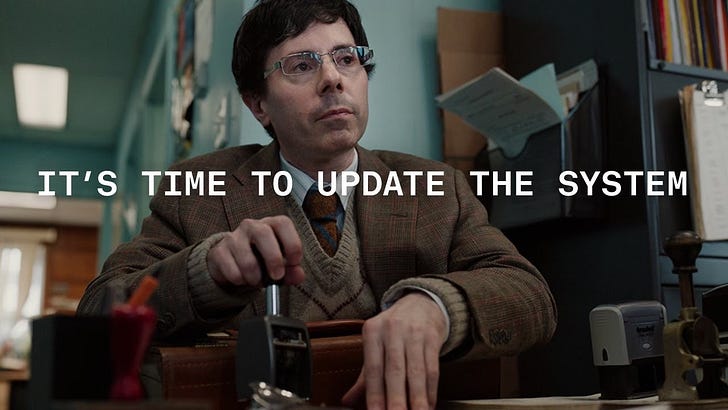Stablecoins and the Capital Market
How Removing Friction in Money Movement Unlocks New Possibilities for Capital Markets
The reason stablecoins are so interesting is that they seem to capture the best parts of 'crypto' while distancing themselves from some of its worst aspects. The longer I study stablecoins and talk to people using them today, the more it appears to me as they unlock a real and functional utility for the financial market.
A Quick Refresher
At its core, blockchain technology is a verification mechanism that allows us to reach consensus without relying on a centralised authority. This consensus is useful for confirming ownership. For instance, if I own 10 of something and you have 0, and I send you 5, the blockchain ledger updates accordingly—showing you have 5 and I have 5. The "thing" on the ledger can be any asset brought into this digital framework.
If this concept feels abstract, think of it like the online versus offline world. Online, you can send things (emails, photos, messages) almost instantly. Offline, you rely on systems like the post office for physical transfers. Blockchain does for value what the internet did for data—allowing you to send assets securely and instantly, with ownership tracked transparently on a ledger with a bank, broker, dealer, agent in the middle.
In the case of stablecoins, the "thing" tracked is typically dollars. Unlike Bitcoin, whose value fluctuates relative to the dollar1, stablecoins are pegged to a fixed value—usually $1 USD. Stablecoins are centralised, meaning a company outhere ensures that each coin is backed by real dollars or equivalent assets. You can think of it as a synthetic dollar or a digital receipt representing one dollar, but transferable via blockchain, with built-in verification.
Stablecoins are about Movement of Money
What makes stablecoins exciting is how they facilitate the movement of money. Let’s take a basic example: sending $100 from one country to another. Comparing traditional banks to blockchain, four key processes emerge:
Compliance with Regulation:
Banks comply with regulations, performing identity checks (KYC) and anti-money laundering (AML) procedures. Blockchain networks don’t inherently support these checks, creating friction with regulators. However, frameworks like Europe’s MiCA are beginning to provide regulatory clarity.Verification:
In traditional banking, intermediaries (using systems like SWIFT or WIRE—the most expensive instant messaging service!) verify transactions, ensuring you have the $100 you intend to send. Blockchain performs this verification directly, eliminating intermediaries.Actual Movement of Money (Speed and Cost):
Transfers via traditional banks often involve central banks or settlement systems like CHIPS (U.S.) or TARGET2 (EU). Where direct relationships don’t exist, intermediary banks facilitate transactions—adding time and cost. Blockchain simplifies this, transferring value in minutes.User Experience:
While traditional finance offers underwhelming user experiences (see below!), it’s still ahead of blockchain, which requires to some extent technical know-how (setting up wallets, accounts with exchanges etc). Blockchain’s UX layer however is improving and depends on entrepreneurs to work out. Tools like Bridge (recently acquired by Stripe) making things easier, by integrating regulatory compliance (KYC/AML) into user-facing applications, making on and off-boarding between crypto and fiat currencies easier.
In short, blockchain eliminates intermediaries in steps 2 and 3, providing nearly free verification, rapid money transfers, and a transparent, open ledger of activity. Networks are continuously evolving—'Layer 2' chains, for instance, are enabling even faster and more cost-efficient transactions. The DeFi ecosystem, a parallel banking universe where many traditional banking functions such as loans and leverage can be performed, relies heavily on stablecoins and depends on these Layer 2 chains as essential enablers for cheap and fast money transfers.
Capital Market Applications
A timlely question to ask is this: with a frictionless, regulator-approved, and cost-free way to send any amount of money to anyone, what are the potential applications for stablecoins in capital markets ?
Stablecoins excel in scenarios requiring frequent, small, cross-border transactions. For example, the Micro Connect model allows small businesses in China to borrow and repay daily percentages of their revenues. A decentralised version of this could spread the risk, enabling businesses to borrow from and repay thousands of investors daily. DeFi could package these loans into index instruments, making them investable assets.
In this model, founders could borrow from investors worldwide and repay frequently (e.g., daily). Alternatively, they could raise equity capital via tokenized shares or debt, which could also benefit from secondary market trading on exchanges or liquidity pools.
Corporate actions could also be nicely streamlined. Companies could use stablecoins to pay dividends directly to shareholders globally, eliminating intermediaries, reducing settlement times, and saving costs. This is particularly advantageous in cross-border scenarios, where traditional systems introduce delays and fees.
For this to happen, the application layer needs to be developed and adopted where the pain points are the most significant. Alternatively, what new applications could be built that we haven’t yet been imagined?
The true potential is enormous. This is because the ‘global capital markets’ are not truly global—they face barriers, inefficiencies, and access restrictions. Stablecoins provide the foundational infrastructure and a new toolkit for companies to address these challenges. While it’s still early days, stablecoins have the power to be a key piece of the puzzle in this system upgrade.
True Bitcoin enthusiasts would argue that it is the US dollar that is unstable, and not Bitcoin



